SUMMARY HIGHLIGHTS
- Learning the art of kintsugi is a great way to culturally immerse yourself in Japan.
- In my opinion, restored pieces highlighted with gold powder look the most striking.
What would you do if you accidentally broke a piece of pottery or ceramic?
Many people would probably just throw it away. If it were an antique or a particularly beloved piece, then you might try to glue it back together. But even if you succeeded, it will always appear broken and less than what it was before.
Not so in Japan.
For the Japanese, a shattered cup doesn’t have to mean the death or devaluation of that cup. Instead, it presents an opportunity to make it even more beautiful and unique than it was originally.
This is known as kintsugi.
You can learn about the fascinating art of kintsugi in Kyoto when you book this experience through Wabunka.
EXPLORE KYOTO QUICK LINKS
To help you plan your trip to Kyoto, I’ve put together links to recommended hotels, tours, and other travel-related services here.
HOTELS
Top-rated hotels in the downtown Kyoto area, one of the most convenient areas to stay for first-time visitors to the city.
- Luxury: Sora Niwa Terrace Kyoto Bettei
- Midrange: Hotel GOCO stay Kyoto Shijo Kawaramachi
- Budget: Kiyamachi Guesthouse
EXPERIENCES
- Cultural Experience: Learn Kintsugi From a Lacquer Artisan
- Kaiseki Cuisine: Enjoy Kaiseki Cuisine at a Centuries-Old Restaurant
- Geisha Entertainment: Enjoy Private Geiko Entertainment in Gion
- Tea Ceremony: Experience an Authentic Tea Ceremony in Uji
- Noh Performance: Experience a Private Noh Performance
OTHER SERVICES
WHAT IS KINTSUGI?
Kintsugi refers to the centuries-old Japanese practice of repairing broken pottery using urushi lacquer dusted with powdered gold, silver, or platinum.[1] Originating sometime between the 14th and 16th centuries, the term stems from the words kin, meaning “golden”, and tsugi, which translates to “joinery”.
Instead of hiding the cracks, the practice of kintsugi accentuates and celebrates them. More than a process of repair, it breathes new life into broken pottery by turning its flaws into the focal point of the restored piece. This is deeply tied to the Japanese philosophy of wabi-sabi, which finds beauty in imperfection and impermanence.
Kintsugi also puts into practice the concepts of mottainai and mushin. Mottainai expresses a deep sense of regret over waste (waste not, want not) while mushin describes a state of flow where the artist creates unconsciously and intuitively.[2]
STYLES OF KINTSUGI
There are three styles of traditional kintsugi[1][2] commonly used to repair broken pottery.
Crack Method
The crack method is the most common form of kintsugi.[2] It entails putting the broken pieces of pottery back together using a minimal amount of urushi lacquer mixed with gold dust or another powdered metal.

Makienaoshi or Piece Method
The makienaoshi or piece method is employed when broken pottery has missing fragments. The missing area is filled in with urushi lacquer dusted with powdered gold in place of the missing fragment.
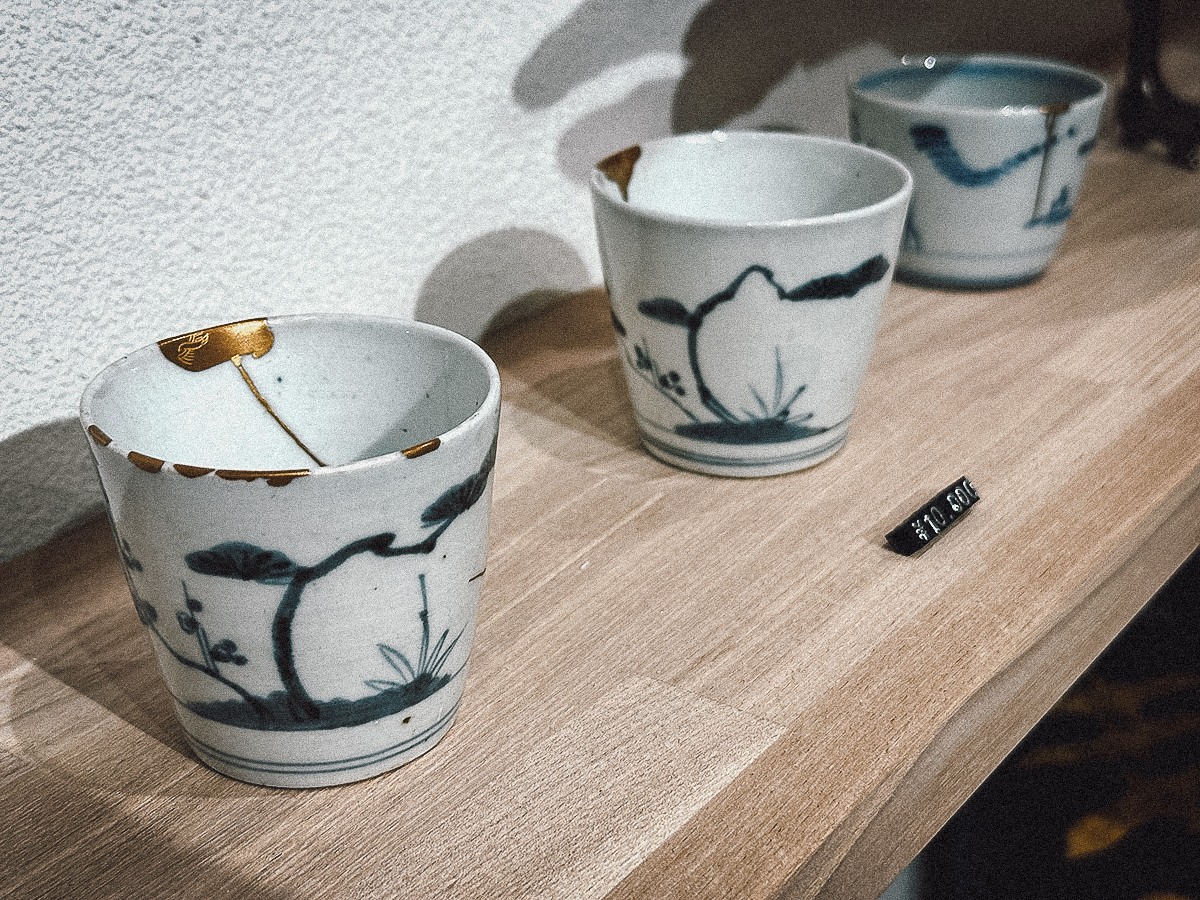
In these examples, tiny designs were drawn onto the lacquer. These cups were gorgeous and demonstrate just how uniquely beautiful broken ceramics can be in the hands of a skilled kintsugi artist.
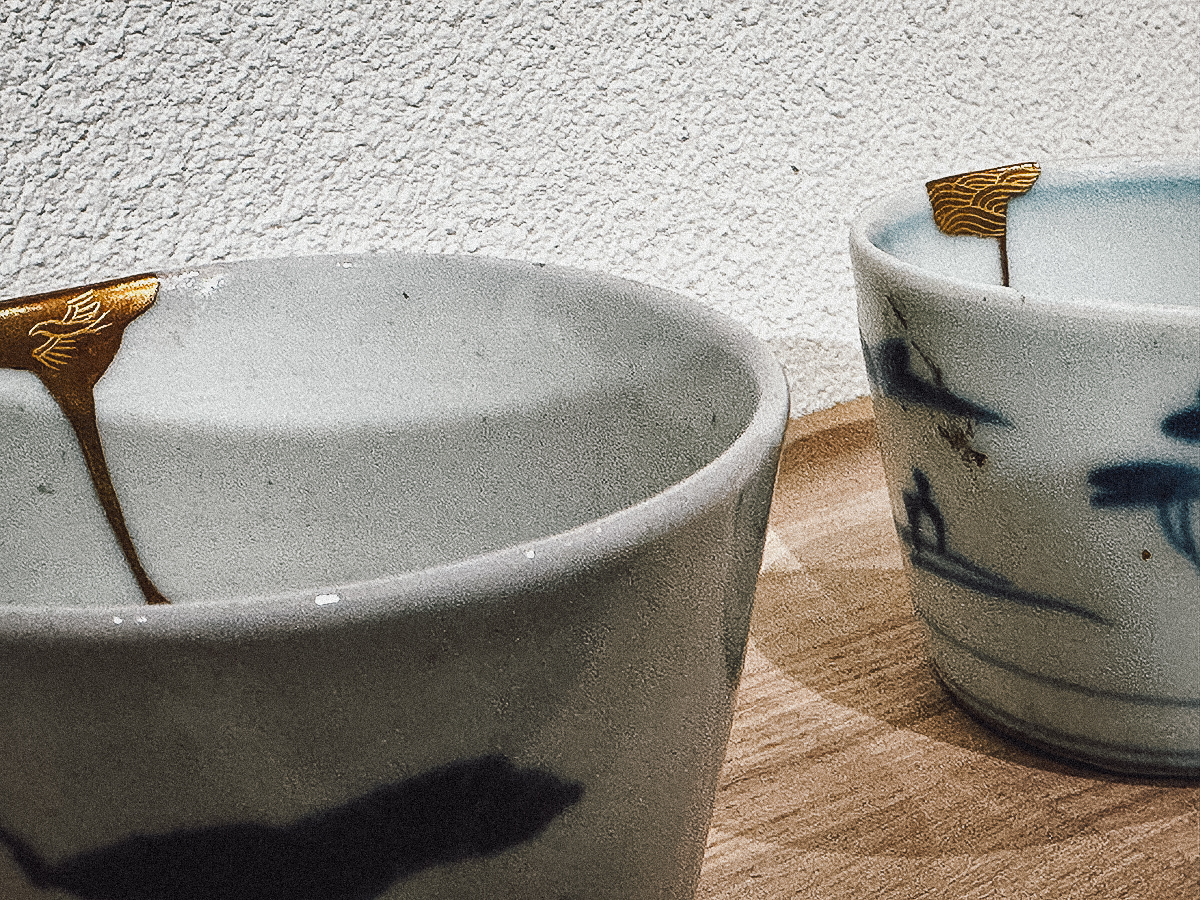
Joint Call Method
The joint call method involves repairing broken pottery with a similarly shaped piece from a different vessel. This essentially combines two different works of pottery into one unified piece.
You can find beautiful examples of the joint call method here and here.
WHAT ARE THE DIFFERENCES BETWEEN TRADITIONAL AND MODERN KINTSUGI?
Traditional kintsugi techniques use urushi lacquer dusted with real powdered gold, silver, or platinum. Sometimes, natural fillers like rice flour or clay are mixed with urushi.[2] Because of the time needed to cure the lacquer – which is often done in multiple stages – it can take weeks, even months, to complete the process.
In modern methods, epoxy resin or other readily available adhesives are used instead of urushi lacquer to bind the broken pieces together. They dry much faster so the process can take just a few hours to complete. Instead of real powdered metal, mica powder or liquid gold leaf is often used to finish the piece.
Modern kintsugi techniques may be cheaper and faster but unlike fully cured urushi lacquer, epoxy resin can be toxic. Broken pottery repaired using modern methods generally aren’t food-safe so they’re limited to decorative purposes only.
WHAT IS HYOBODO?
Hyobodo is a workshop in Kyoto that specializes in lacquer crafts, including kintsugi. Located in Ukyo Ward, in a more residential part of Kyoto City, it was founded by husband and wife team Terunori Sugimoto, a lacquer artist, and Megumi Shimamoto, a makieshi artist who decorates lacquer with powdered gold.
In this Wabunka exclusive, participants will have their choice of broken pottery to restore using modern kintsugi techniques. Due to time constraints, traditional methods aren’t possible. Restored pieces will then be decorated with tin or LG powder (aluminum with gold plating) but if you prefer something a little more boujee, then you can upgrade to gold or silver.
Japanese tea and sweets will be served during the class. At the end of the session, your finished pieces will be packed in sturdy boxes to take home with you.
Visit Wabunka for more information and to book this kintsugi class in Kyoto.
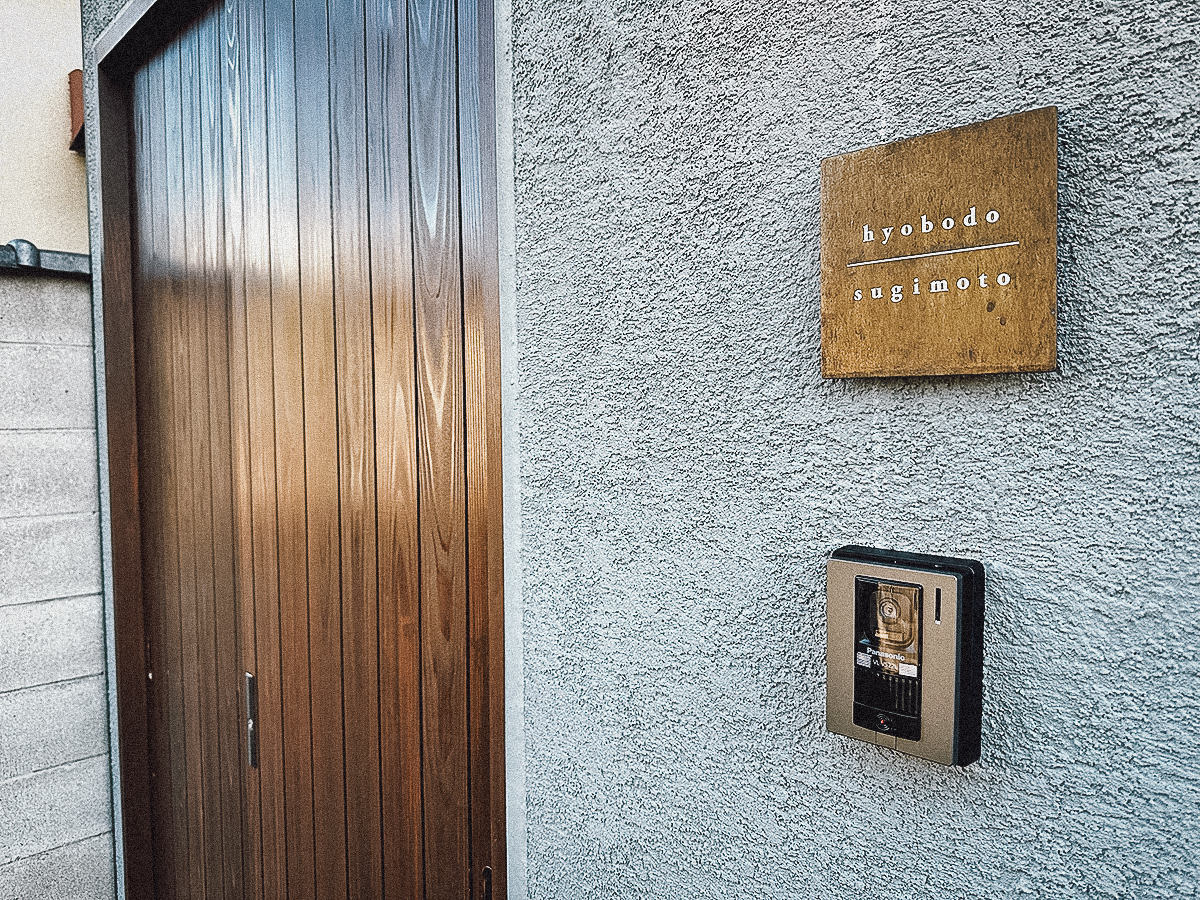
RELATED ARTICLE: Luxury Experiences in Kyoto
BREATHING NEW LIFE INTO BROKEN POTTERY AT HYOBODO
Hyobodo is located in a residential part of Kyoto City, in a quiet neighborhood that tourists would otherwise never go to. Not that they’d have any compelling reason to come here, but it did provide us with a welcome getaway from the overcrowded streets of downtown Kyoto.
Shortly after arriving at the studio, we were met by our invaluable translator Chika. She introduced us to our instructor (apologies, I forget her name) who then seated us at our work desk and served us cups of warming Japanese tea.
As you can see below, the tools of the trade were already laid out before us.
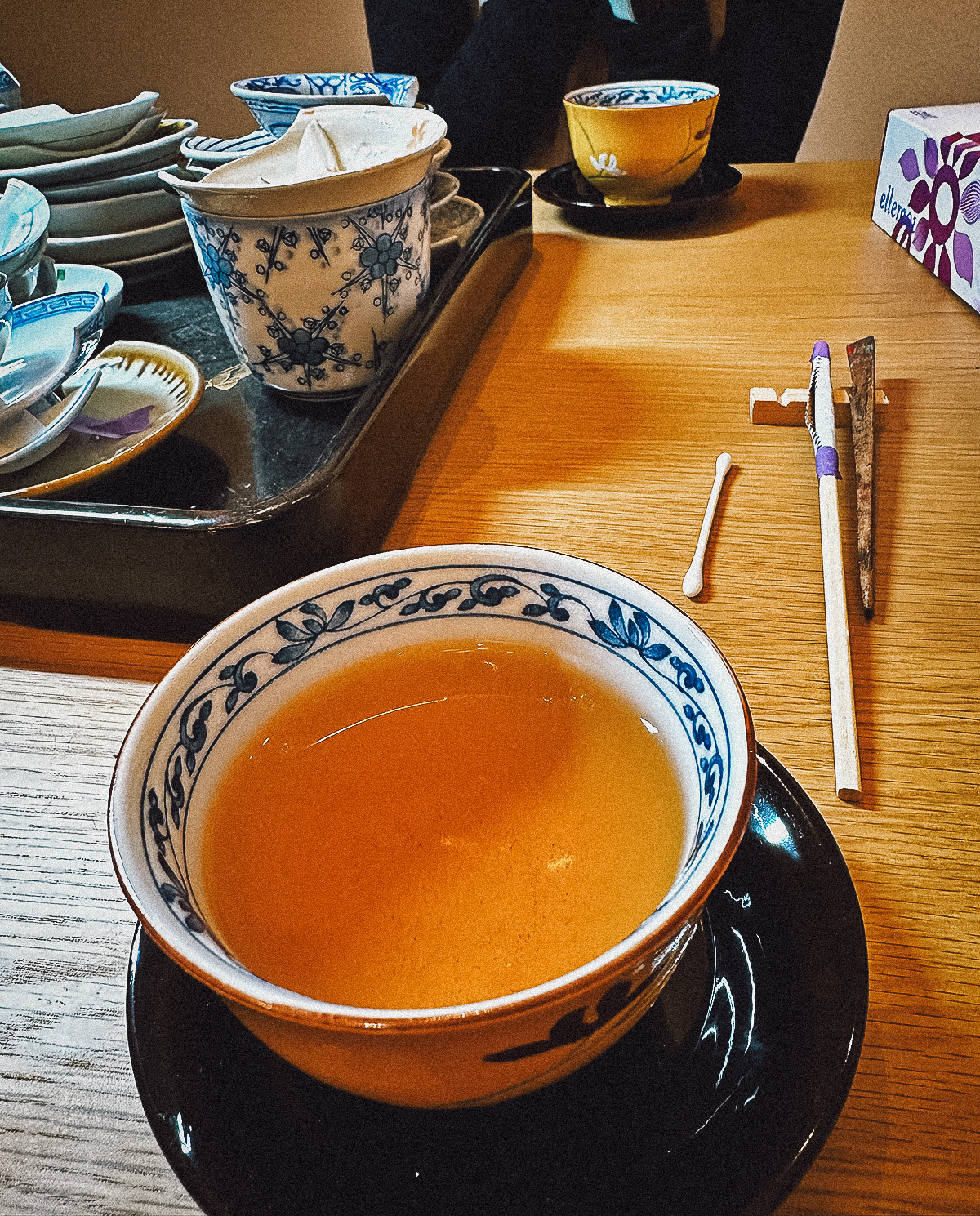
With Chika translating, our instructor opened up a Japanese kintsugi book and gave us a brief but informative talk on urushi lacquer. Urushi lacquer is a natural lacquer produced by the urushi tree (Toxicodendron vernicifluum), a deciduous tree native to East Asia – particularly Japan, China, and Korea.[3]
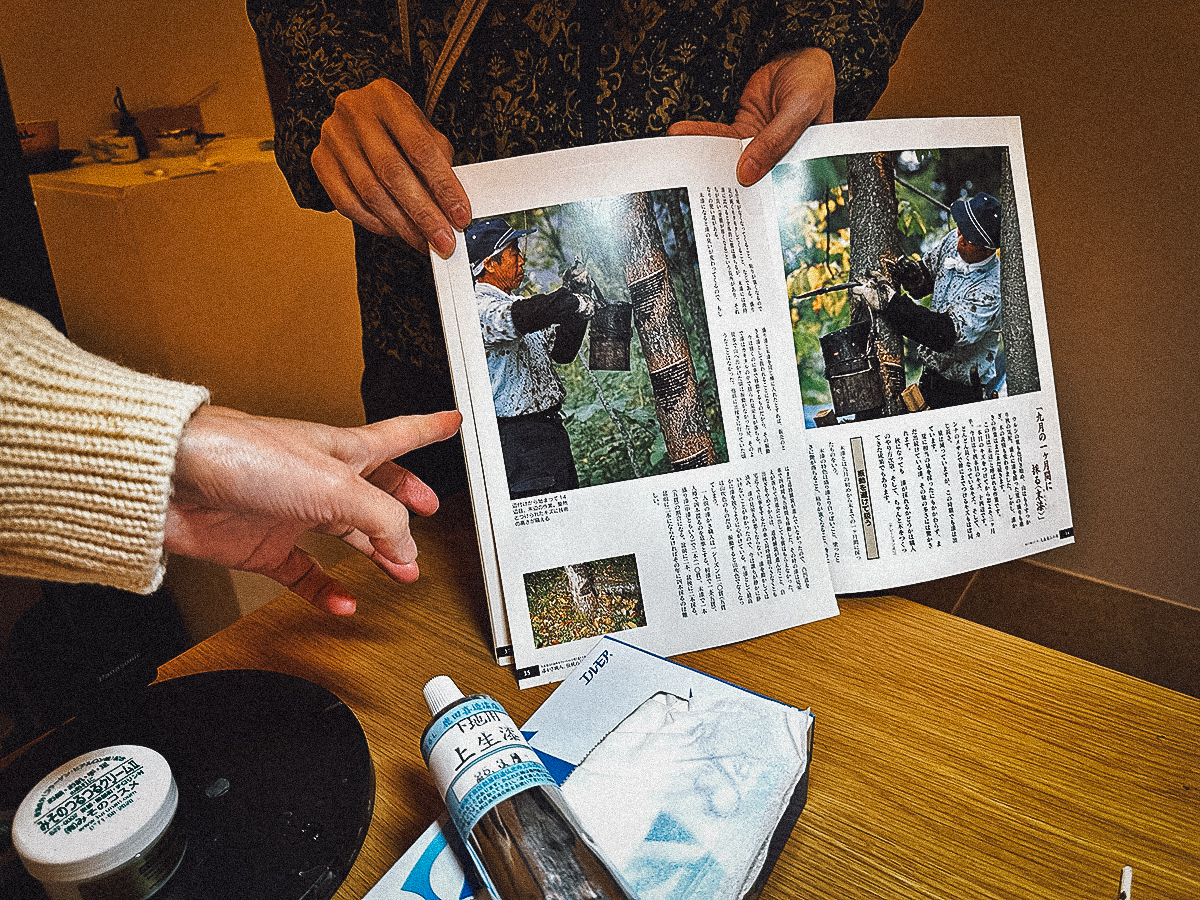
According to our instructor, a single urushi tree produces only around 250 ml of urushi lacquer in its lifetime. That’s the same amount as what’s contained in the tube pictured below. This explains why products made with urushi lacquer tend to fetch a high price.
I did a quick search online and found tubes of urushi lacquer being sold on Amazon for a whopping USD 62 per 100 grams.
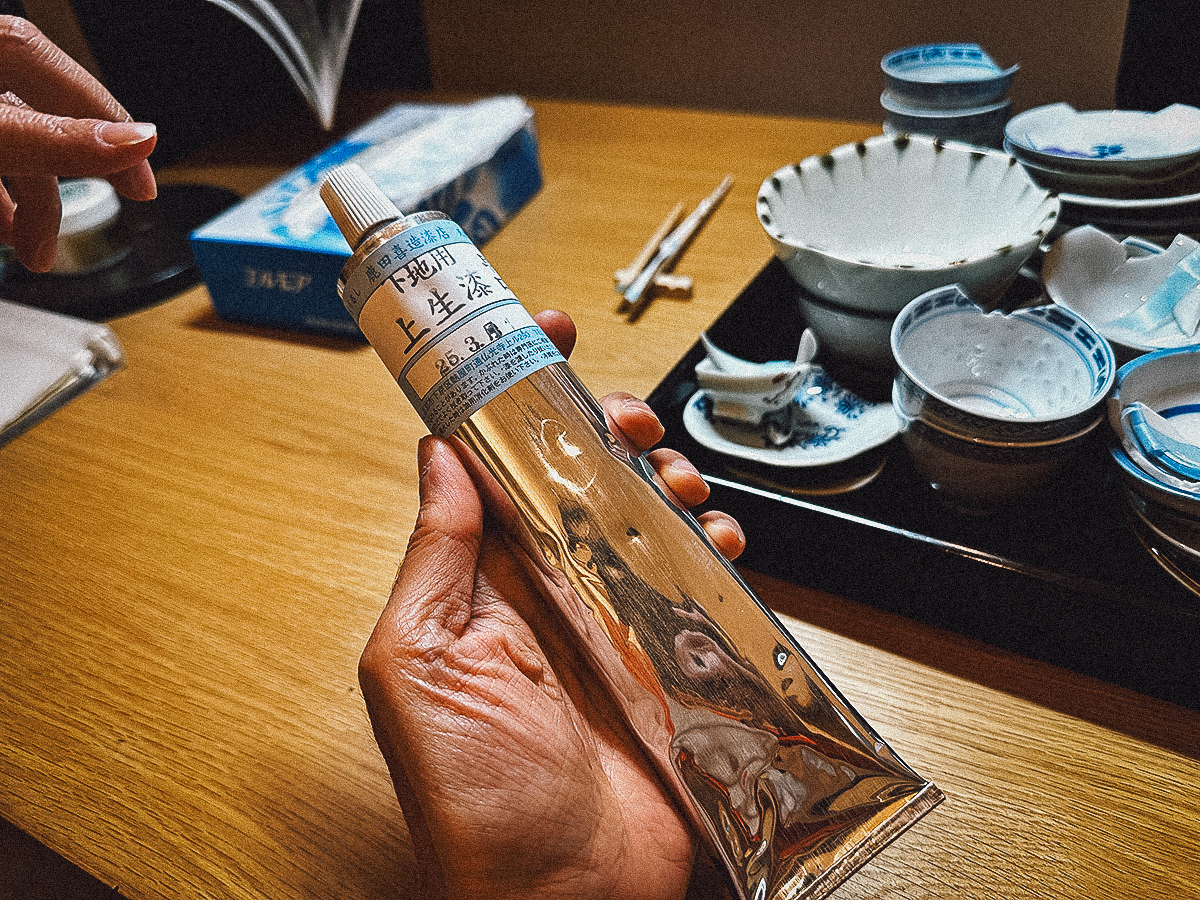
After the lecture, we were asked to select pieces to fix from a tray of broken ceramics.
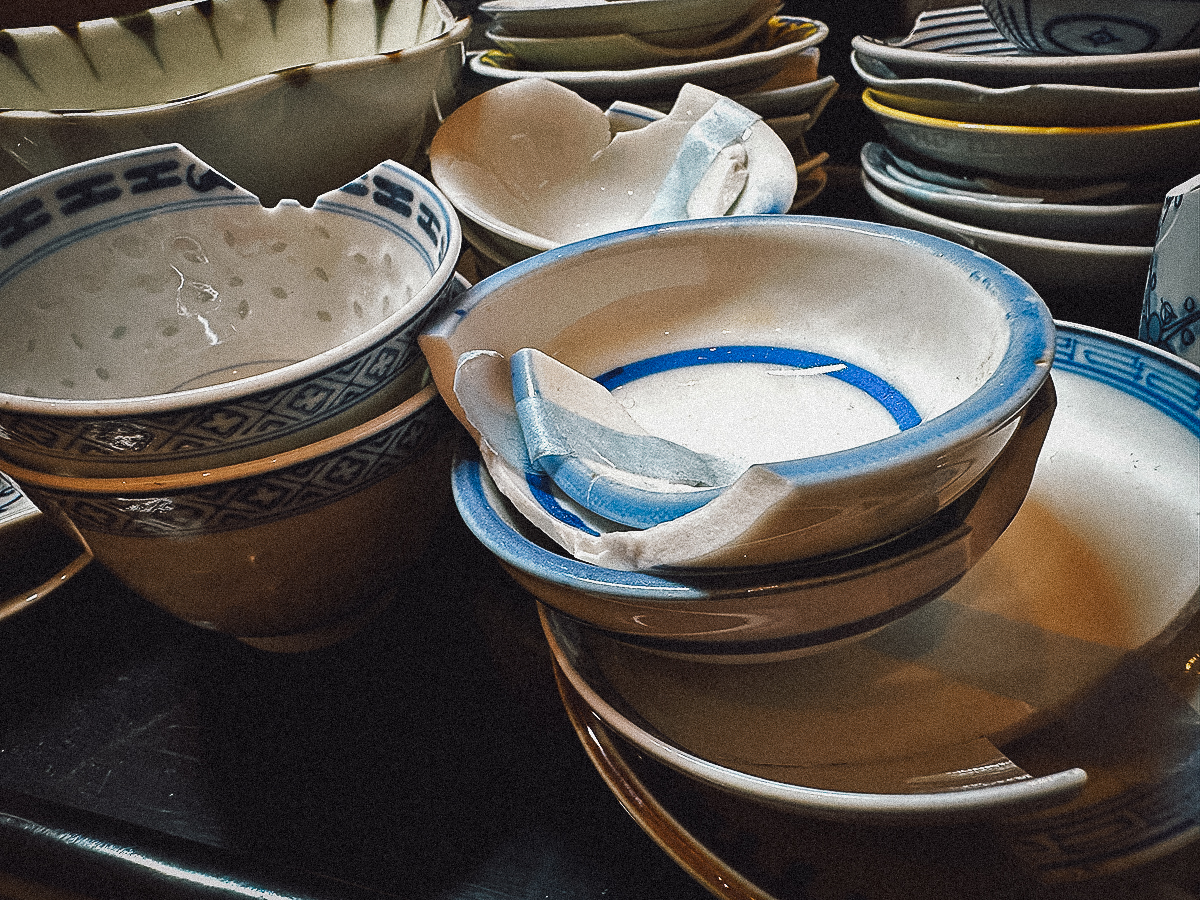
We wanted pieces that could fit on a display shelf at home so we picked this sake cup and small dish. We wanted pieces with interesting breaks to help accentuate the gold and silver powder.
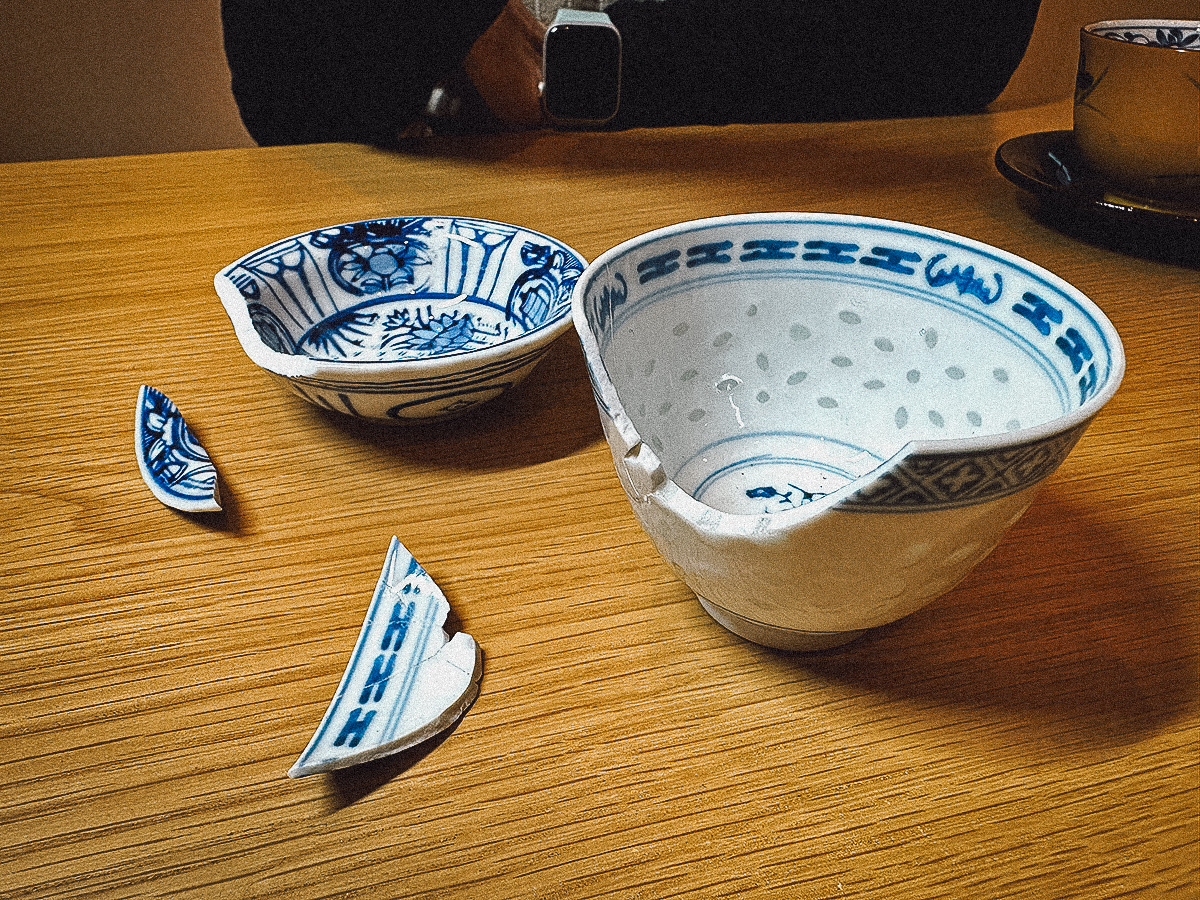
The first step in the process involves sanding the broken edges down. The goal is to create a shallow groove along the cracks that can be filled in with putty and urushi lacquer.
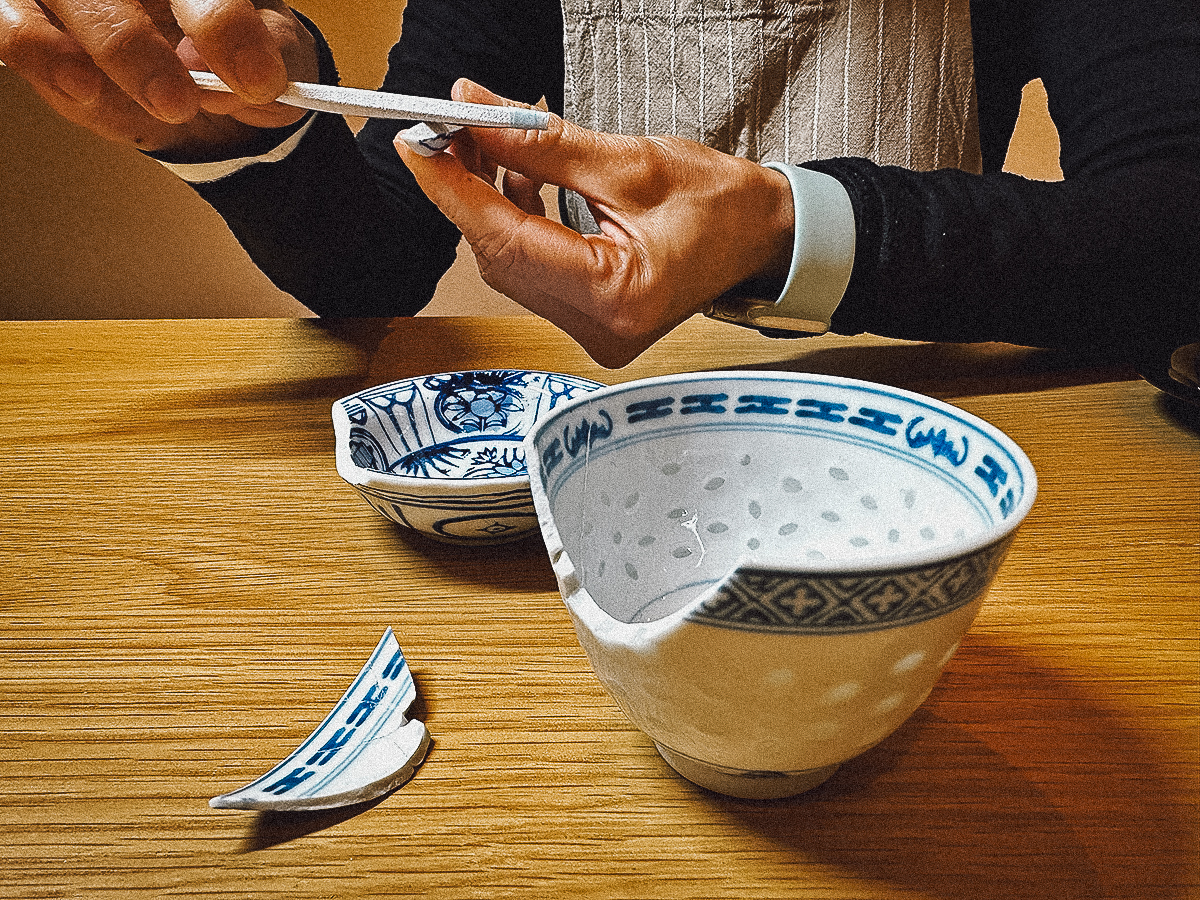
After sanding the pieces down, we put them back together using quick-drying epoxy resin. It’s the same stuff you can find at any hardware store.
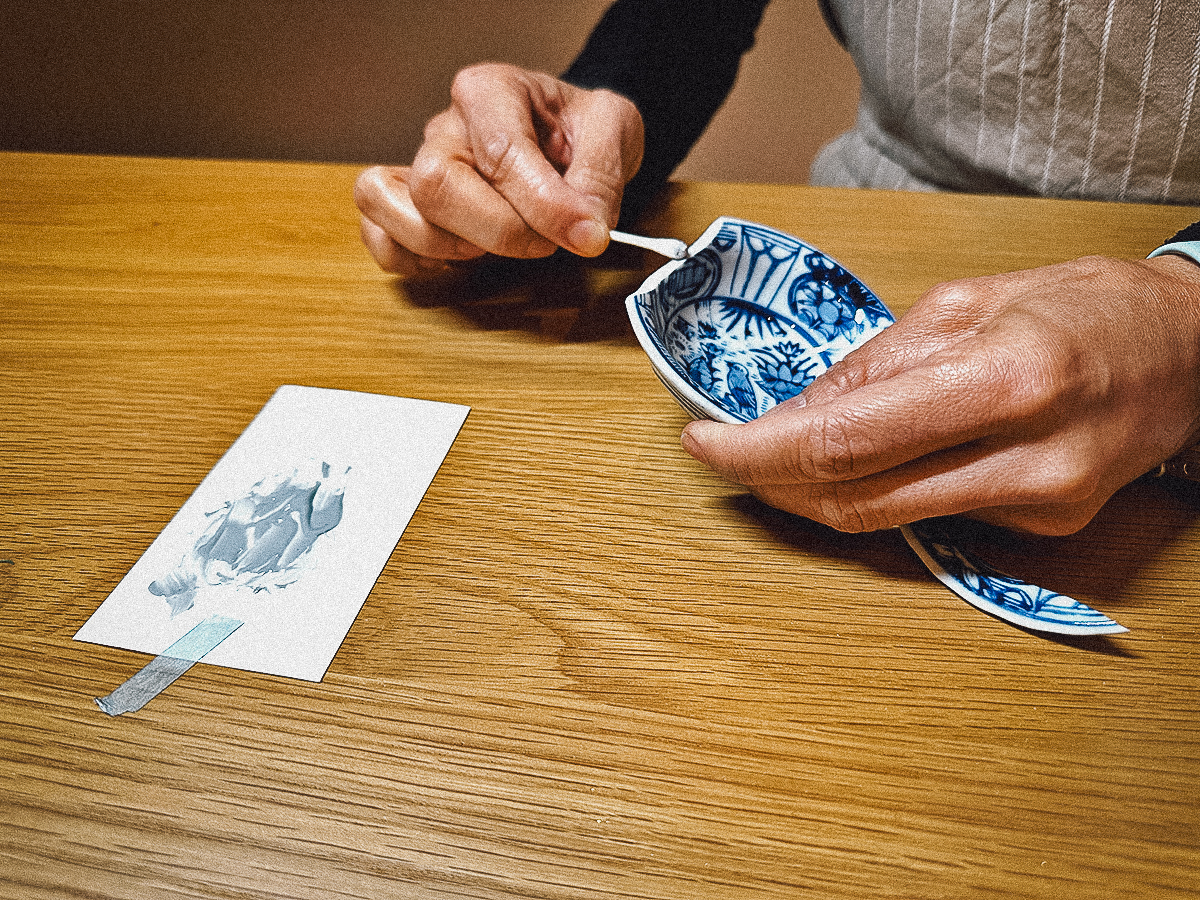
Our instructor then stuck cotton swabs on our leftover epoxy resin. When they can stand upright on their own, then you’ll know that the epoxy resin has dried enough to proceed to the next step.
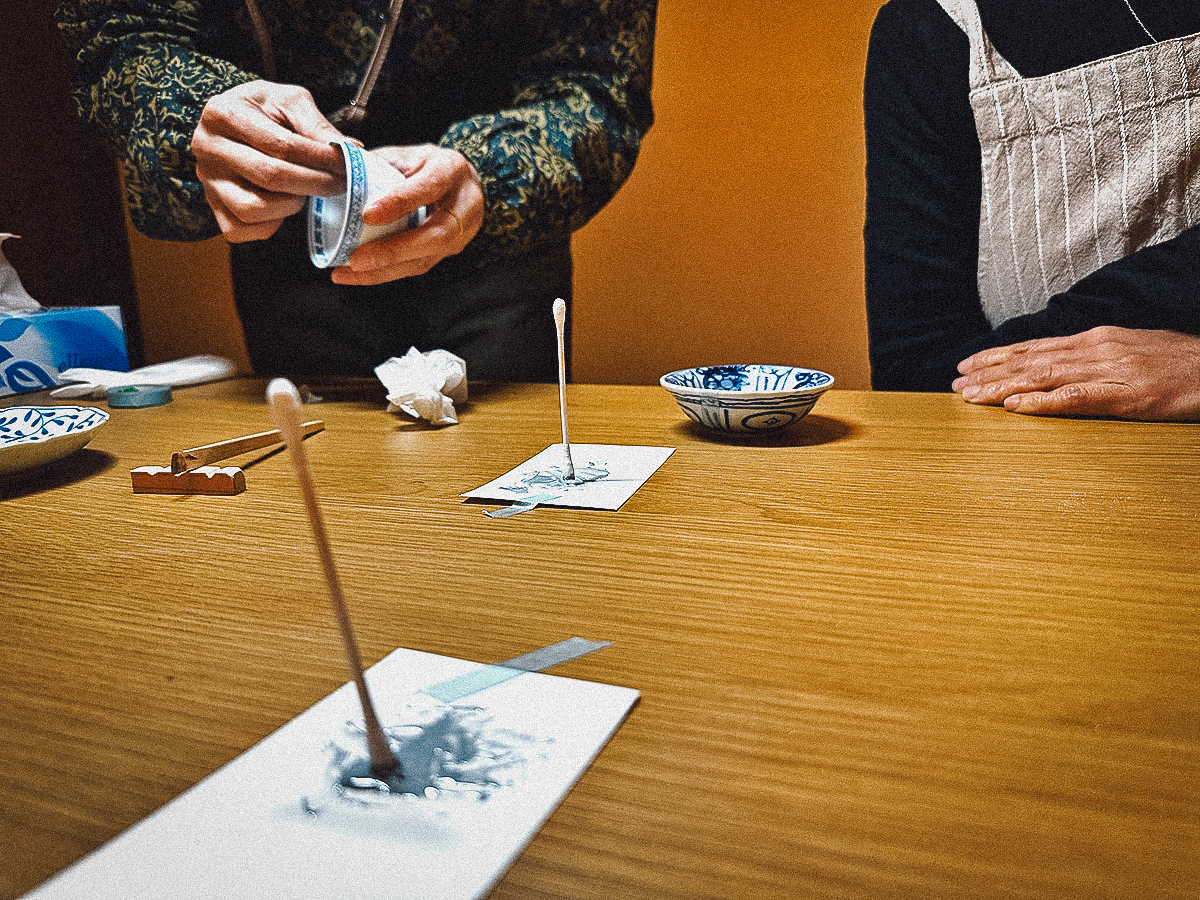
My sake cup had an interesting pattern of cracks, including a small hole, so I was excited to see how mine would turn out.
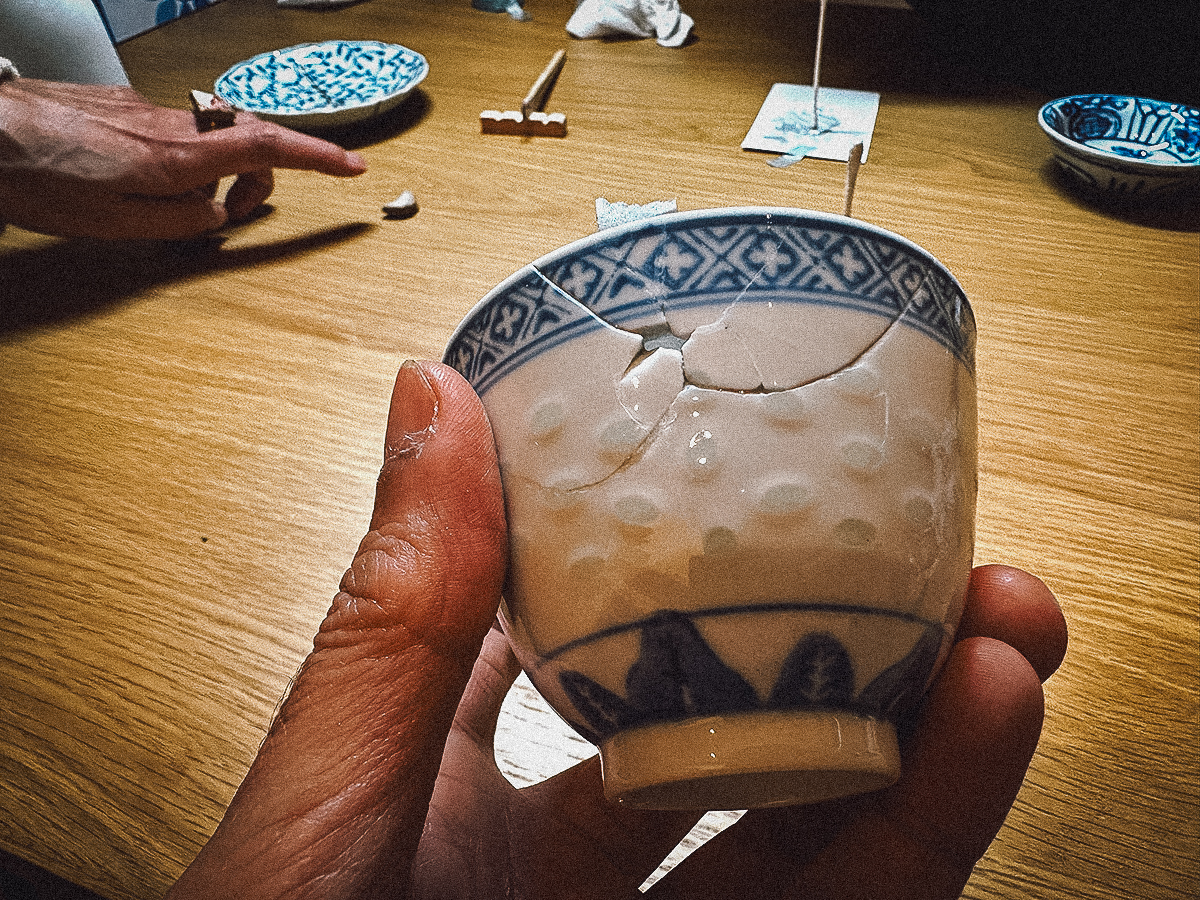
As previously described, only urushi lacquer and natural fillers are used in traditional kintsugi but in modern methods, holes and larger gaps are filled in with putty.
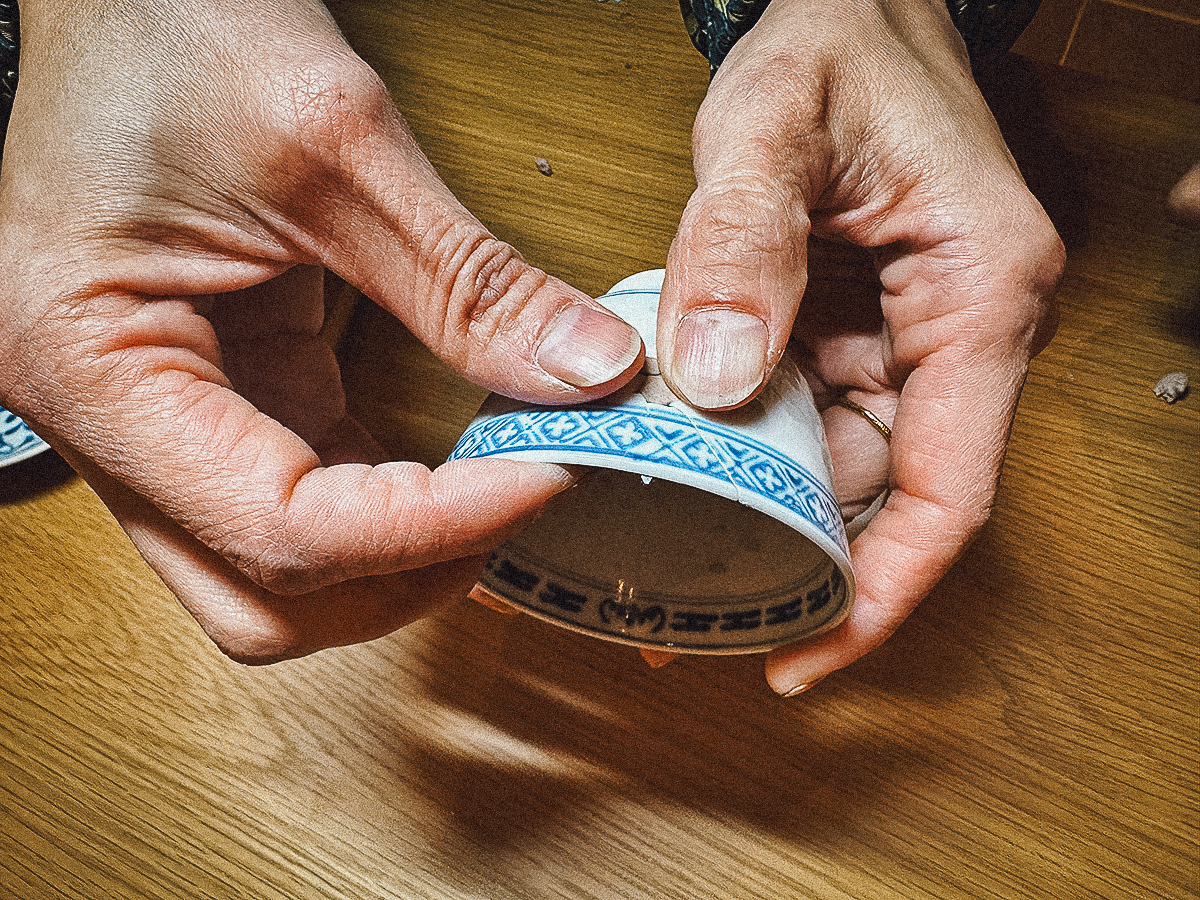
After the larger gaps have been filled in with putty, a softer more viscous substance is used to fill in the tinier cracks.
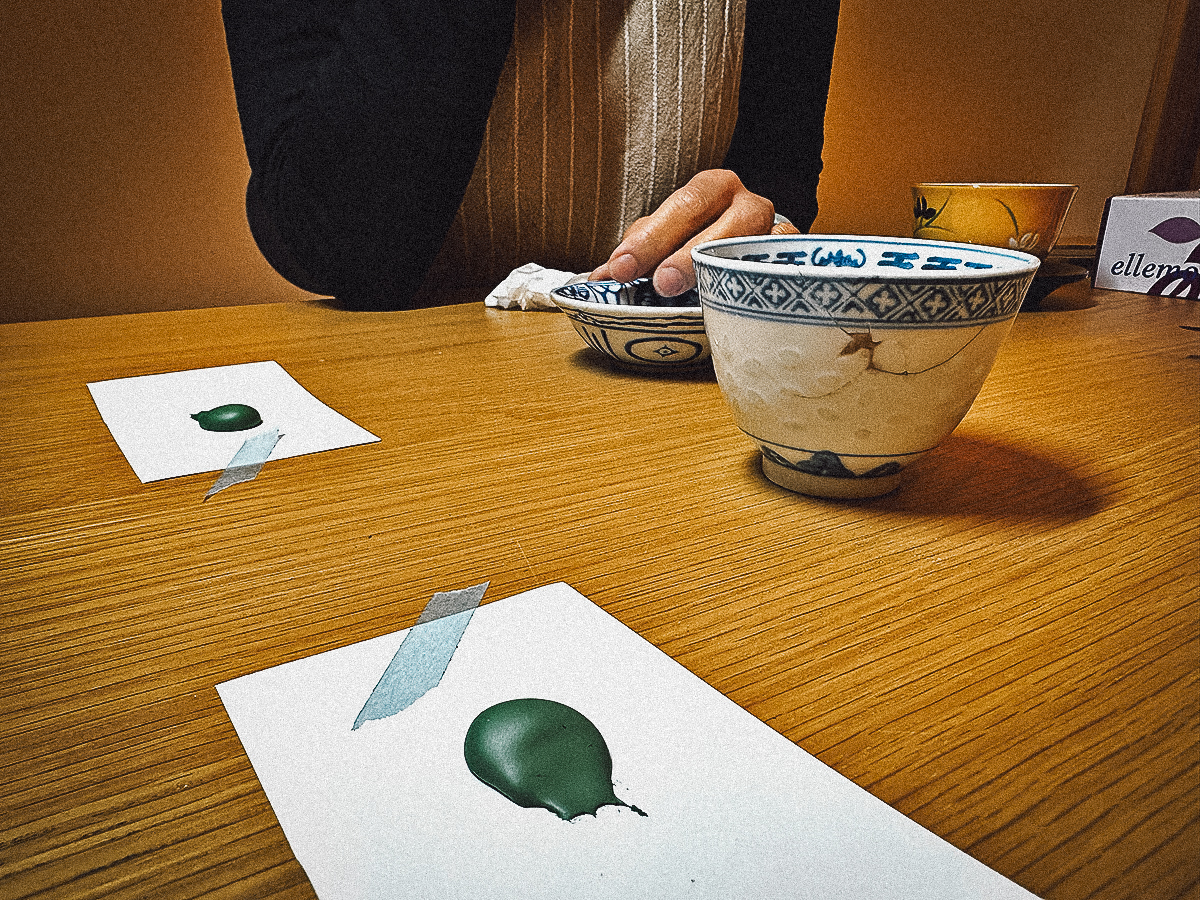
Using spatulas, we filled in the tinier cracks with this green, putty-like material.
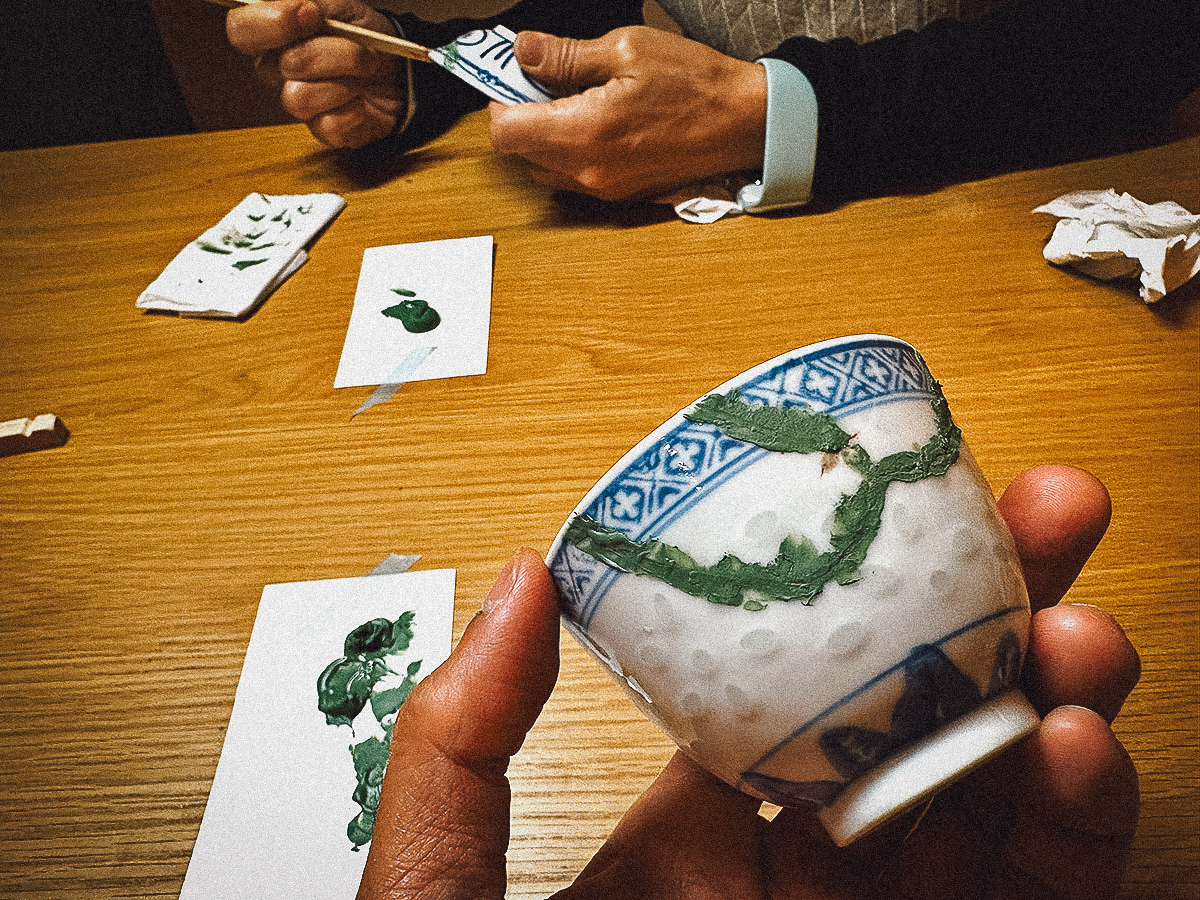
Here’s a work-in-progress of my cup after the excess material had been rubbed off. The cracks are starting to look beautiful!
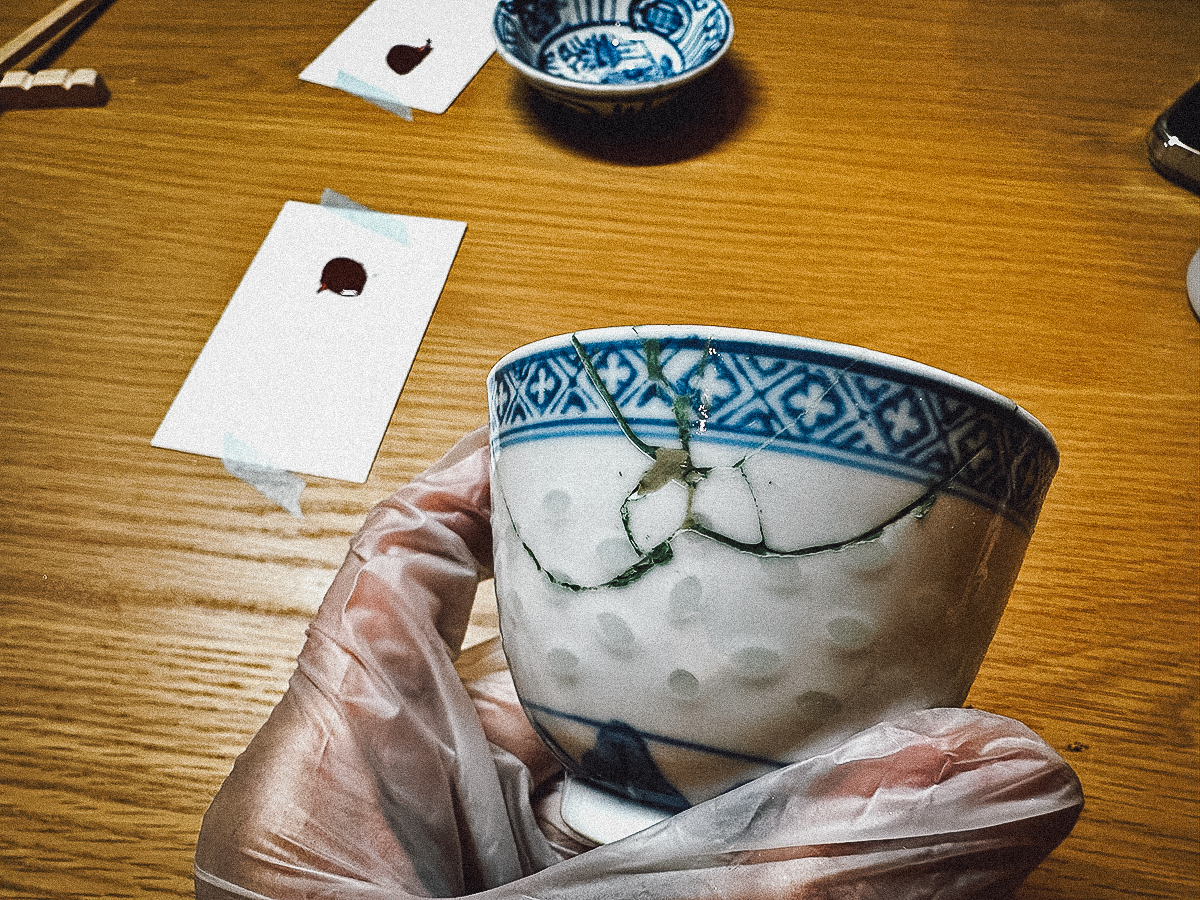
Now this is where the real fun begins – brushing on the urushi lacquer. For this task, two types of brushes are used – flat hake brushes for filling in larger surface areas and thin fude brushes for fine detail work. In our case, only fude brushes were needed.
Urushi lacquer brushes can be made with a variety of fine animal hair like weasel, horse, rat, rabbit, and cat. In certain types of urushi brushes, high quality human hair is also used.[4]

After spending a few minutes practicing, we were ready to carefully brush the urushi lacquer onto the cracks. Urushi lacquer is very tacky so you need to be careful not to accidentally smear it with your fingers.
In its wet form, urushi lacquer is toxic and contains urushiol – the same compound found in poison ivy, poison oak, and poison sumac.[3] For that reason, we were asked to wear gloves and arm sleeves for this step of the process.
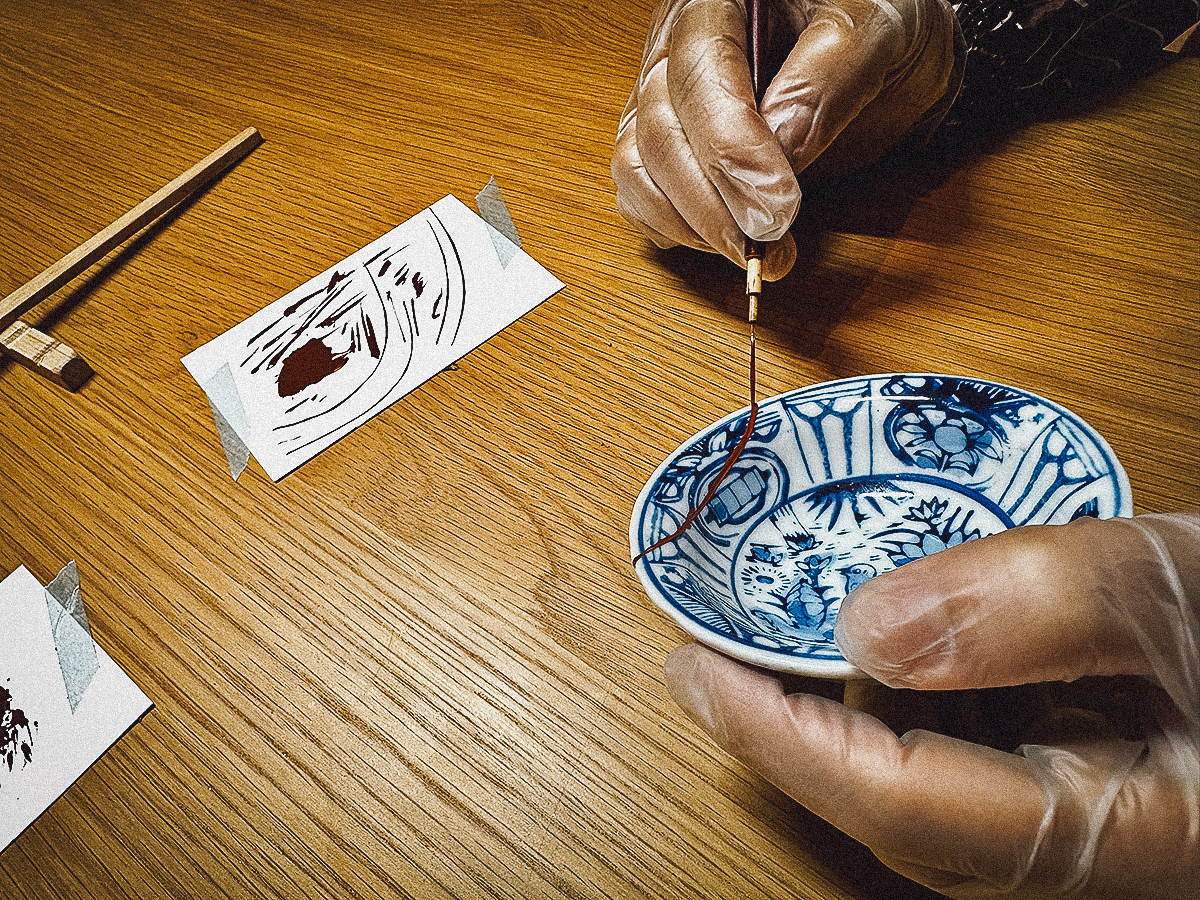
After brushing on the urushi lacquer, our instructor took our pieces to a different part of the studio, presumably to help them dry faster. While we waited, she served us these bowls of matcha with Japanese sweets.
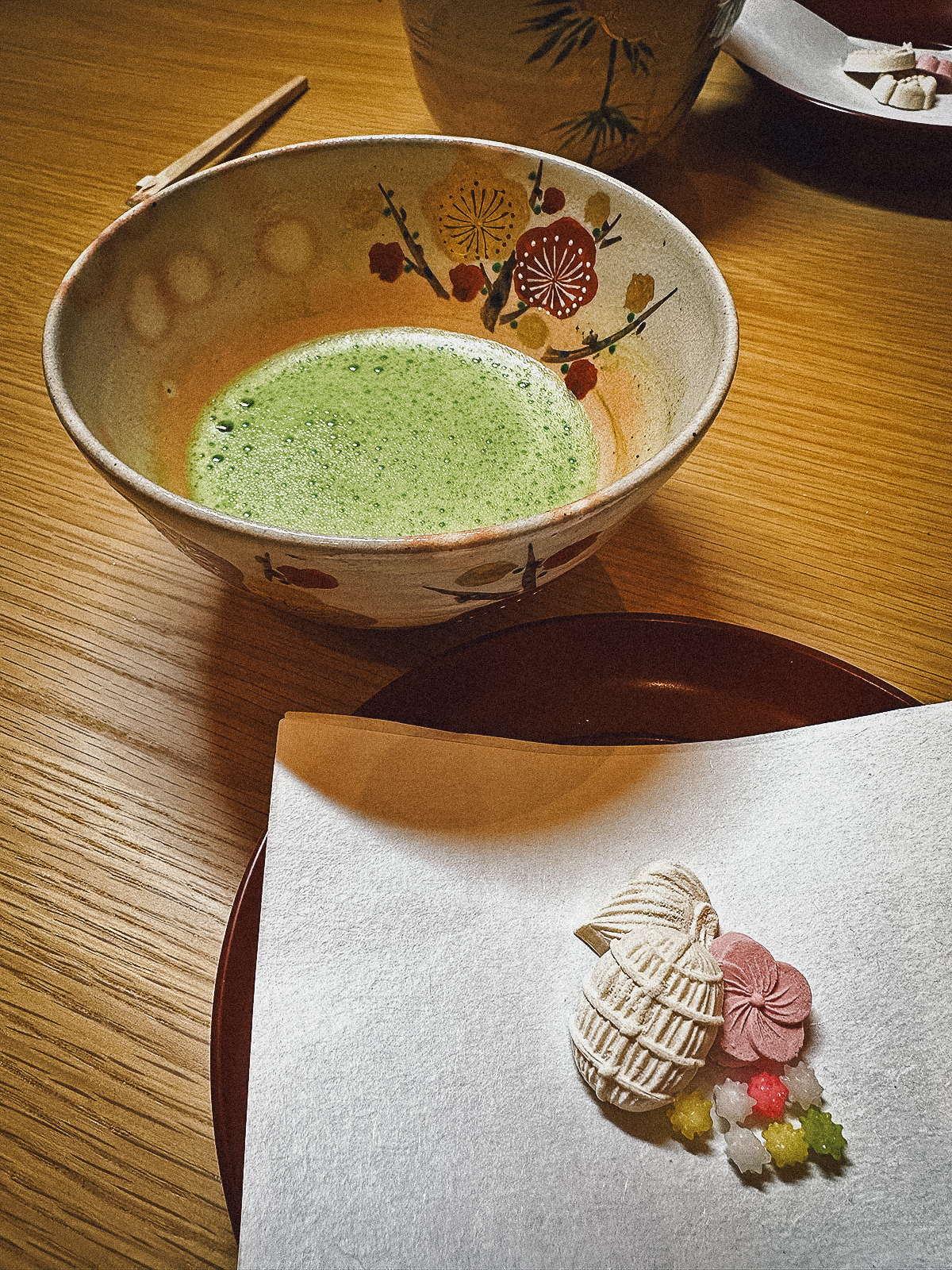
After the urushi lacquer had dried enough, we were ready for what our instructor described as “the most satisfying part of the process” – dusting on the powdered metal.
This Wabunka experience comes with either tin or LG powder but you’ll have the option of upgrading to gold or silver if you like. I went with silver while my partner upgraded to gold.
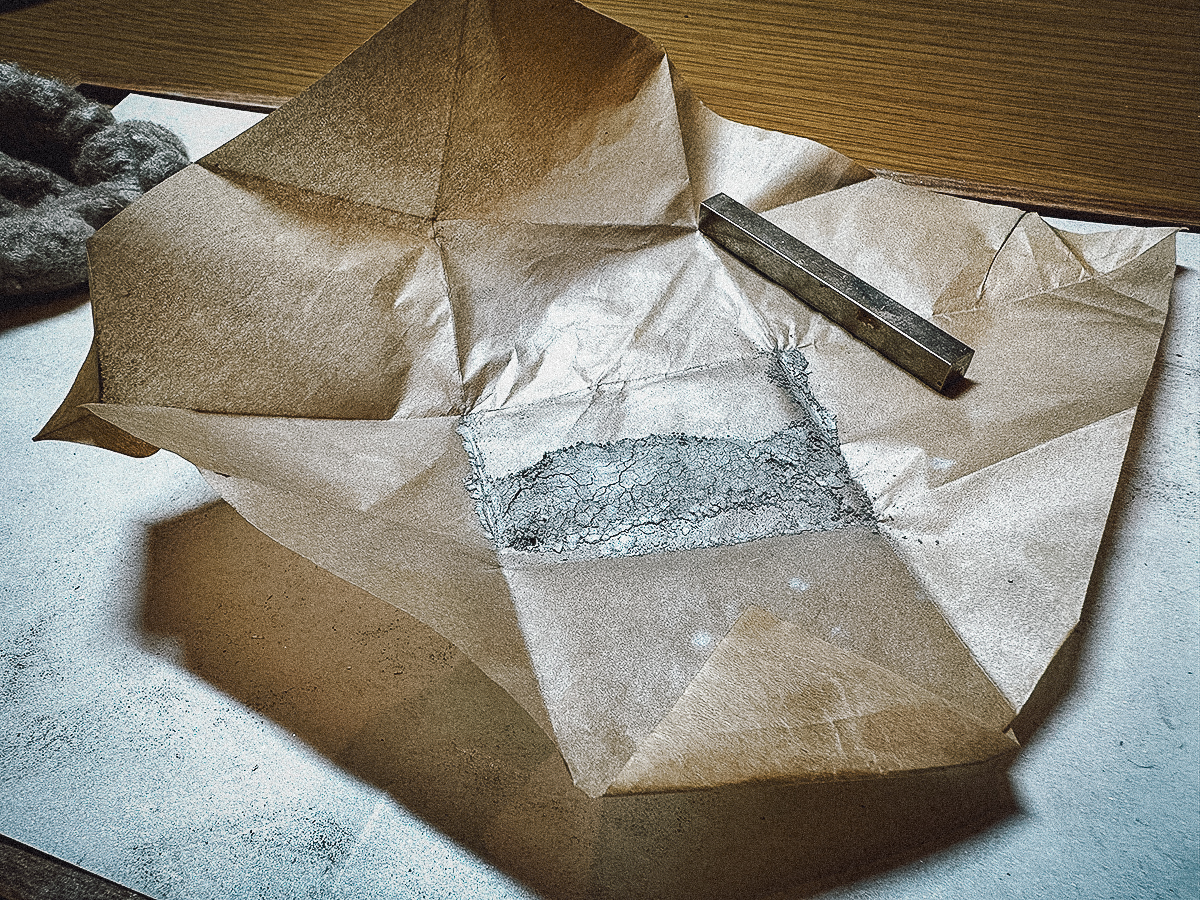
In this stage, ashirai kebo brushes[4] are used to apply the powdered metal onto the still-tacky urushi lacquer.
Our instructor was right. It really was satisfying to see the gold and silver powder adhere itself to the lacquer. This process was easy and didn’t require much finesse or thought.

And voila! Our better-than-new ceramics restored with modern kintsugi techniques. My partner’s dish definitely turned out better than mine.
My cup looks a little clumsy and heavy-handed, but still not bad for a first try. I think the application of the putty can be cleaner (perfectly flat and smooth), plus the line quality of the brushed-on urushi lacquer needs improvement (varying degrees of thickness).
In hindsight, I would have upgraded to the gold powder as well. The silver looks nice but it isn’t quite as striking as the gold. What do you think?
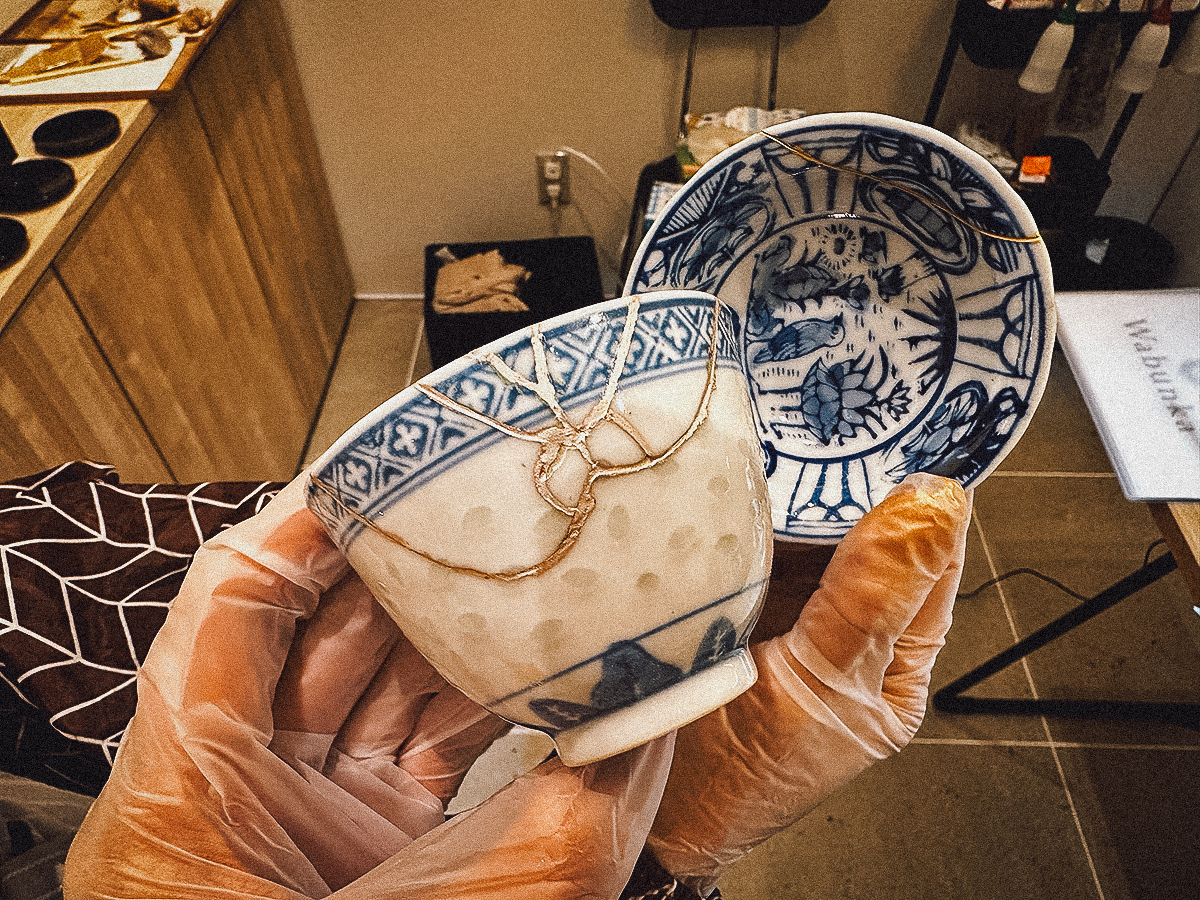
The urushi lacquer and powdered metal will need a few days to completely set so our instructor adhered them to the inside of these boxes to give them time to dry without being agitated during transport. Arigato gozaimasu!
When you attend this class, be sure to bring a large enough bag so the boxes are easier to carry back to your hotel.
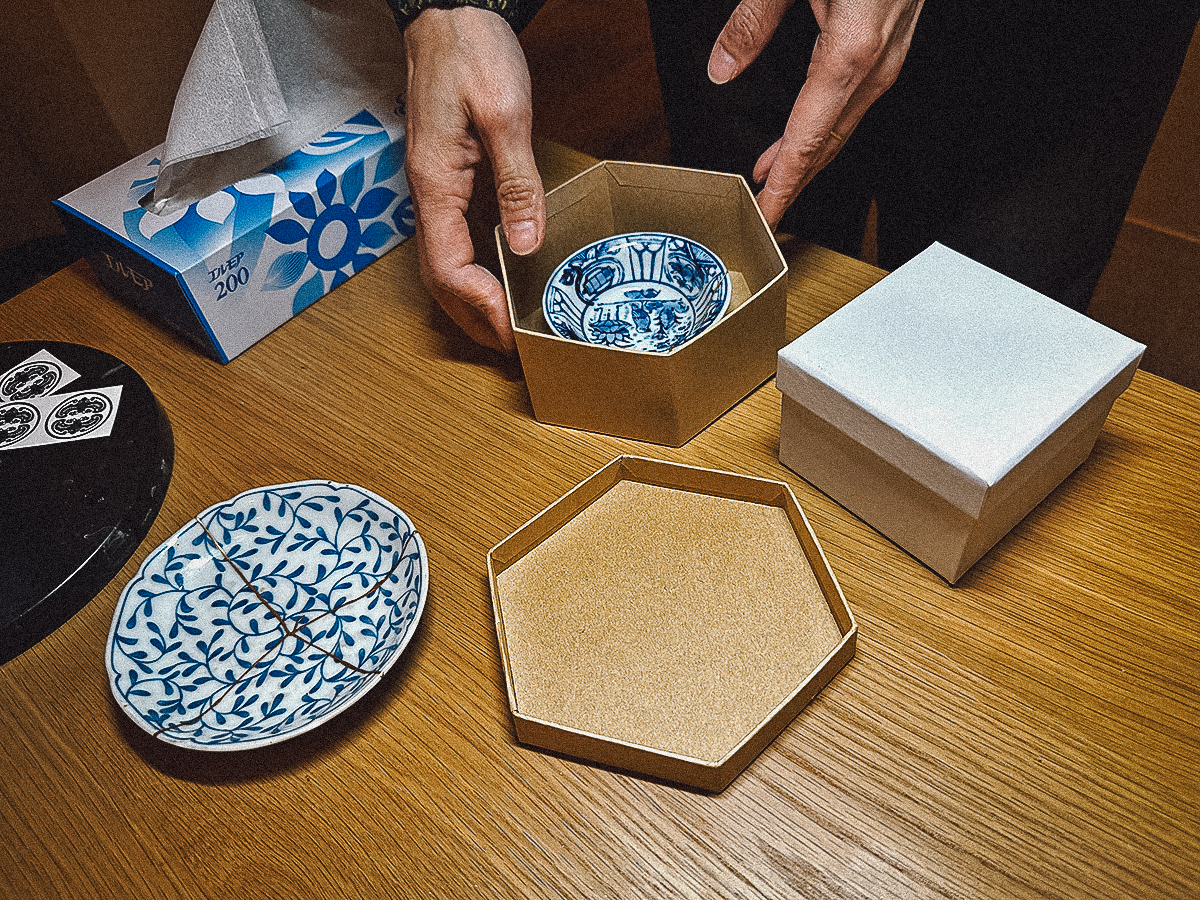
And here’s my better half’s beautifully restored dish proudly on display at our home. I love it!
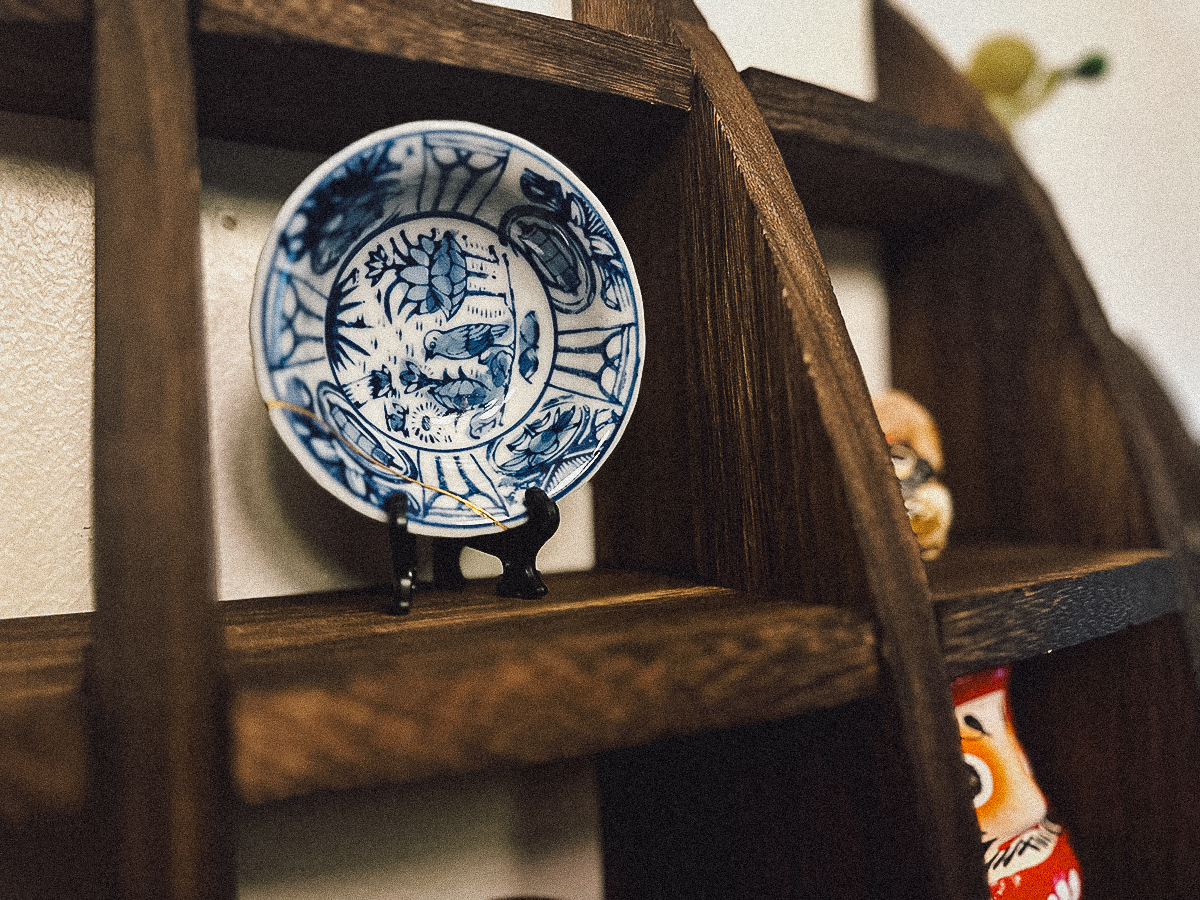
THE FINAL SAY
There are many interesting cultural experiences you can have in Japan but for me, formal tea ceremonies and kintsugi are among the most fascinating. My partner and I are happy and thankful to have finally experienced the latter in Kyoto.
Not only is the restored piece of pottery even more beautiful and interesting than it was before, but there seems to be an important life lesson in kintsugi. To accept change and celebrate flaws and imperfections. Perhaps we can all learn something from this experience?
Thanks again Hyobodo and Wabunka for the fantastic experience! We’ll never forget it.
If you’d like to try your hand at restoring broken pottery in Kyoto, then you can book this same kintsugi experience at Hyobodo through Wabunka.
Disclosure
This article on kintsugi in Kyoto was written in collaboration with Wabunka. As always, all words, opinions, and thoughts expressed in this article are mine and mine alone.
Some of the links in this article are affiliate links, meaning we’ll make a small commission if you make a booking at no added cost to you. As always, we only recommend products and services that we use ourselves and can personally vouch for. We really appreciate your support as this helps us make more of these free travel guides. Arigato gozaimasu!
References
1. Kintsugi. Wikipedia. (2009, March 3).
2. Kintsugi Pottery: The Art of Repairing With Gold. Invaluable. (2018, April 9).
3. Toxicodendron vernicifluum. Wikipedia. (2006, June 11).
4. https://www.urushilab.com/urushi/tools/. UrushiLAB. (2022, January 15).
